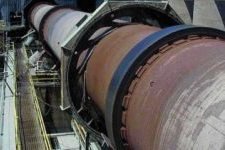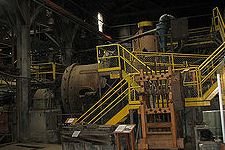- Turnkey Cement Plants
- VSK Cement Plants
- Rotary Kiln Plants
- Portland Cement Plants
- Clinker Cement Plants
- Mini Cement Plants
- Material Handling Equipments
- Cement Plant On Turnkey Project Basis
- Cement Plant Equipments
- Cement Plant Machines
- Crushing Screening Equipments
- Bucket Conveyor Manufacturer
- Cement Plant Process






Cement Plant Manufacturers

Cement Plant Manufacturers: Industry Overview
Indian cement industry is one of the second largest country after China, Millions of people employing throughout the country. As Cement Plant Manufacturers serving turnkey projects in Cement Industry. Indian Cement Industry contributes a big part in our economy, foreign companies are regularly investing billions in Indian Cement industry after regulations were lifted off in 1982. At present Indian companies are building new technologies in terms of energy efficiency, safety and Production.
India is a fast growing country, has lots of potential for development in terms of infrastructure and construction sector and the cement sector is expected to largely benefit from it. Recent government initiatives are also gives a major boost because of developing 98 smart cities. Dement of cement and Plantsexpected to increase due to large infrastructure projects, leading to 45 - 55 million tonnes (MT) of cement needed in the next three to four years (according to report by Nomura Research dated October 13, 2015).
Understanding Of Cement Plant Process
Cement is a fine powder which sets after a few hours when mixed with water, and then hardens into a solid material. Cement is mainly used to bind fine sand and coarse aggregates together in concrete. Portland Cement was first invented by Mr. Joseph Aspdin in 1824, name portland was given owing to resemblance of this hardened cement paste to the natural stone available at a place called Portaln in England.
Cement Plant Manufacturing Process
Materials needed to produce cement
The raw materials needed to produce cement (calcium carbonate, silica, alumina, and iron ore) are extracted from limestone rock, chalk, shale, or clay. These raw materials are won from the quarry by either extraction or blasting. These naturally occurring minerals are then crushed through a milling process. At this stage, aditional minerals are added to ensure the correct chemical composition for making cement. These minerals can be obtained from the wastage or by-products of other industries, such as paper ash. Milling produces a fine powder, known as raw meal, which is preheated and then sent to the kiln for further processing.
(1) Limestone: - Contains predominantly calcium carbonate (CaCO3) and to use in cement manufacture, it should have 42-43% lime (CaO) minimum. In cement manufacture it is prime raw material and its usage would be 90- 93%.
(2) Clay: - It contains more of silica (SiO2) and its usage should be 2 to 3% in cement manufacture.
(3) Bauxite: - It contains alumina (Al2O3) and it's usage should be 2 to 3% in cement manufacture.
(4) Iron Ore: - It contains mainly iron oxide (Fe2O3) and it's usage should be 1 to 2% in cement manufacture.
The raw materials mix composition would be 90-93% limestone, 2-3% clay, 2-3% Bauxite, 1-2% Iron ore in cement making. Coal is used for burning the raw mix in powdered form. Normally both imported and indigenous coal are used, coal is being imported from mainly South Africa, Australia etc. because of low ash content. Pet coke is also used as alternate fuel while manufacturing of cement.
Process & Steps in Cement Plant Manufacturing
Raw Material Prepration
Limestone: The basic raw material is limestone, after blasting in mines is broken into big boulders and transported by dumpers to limestone crusher where it is crushed to 15 to 20mm size.
Stacker / Reclaimer: After crushing process, crushed limestone is piled longitudinally in stacker / reclaimer. The stacker deposits limestone longitudinally in the form of a pile, later reclaimer cuts the pile vertically, simultaneously from top to bottom to ensure homogenization of limestone. Crushed limestone from pile is transported through Belt Conveyor to hopper including clay, bauxite, iron ore and other raw material. All raw materials are proportioned in requisite quantity through weigh feeders.
All this proportioned raw materials are transported by Belt Conveyor to Raw Ball Mill for grinding into powder form. After the ball mill grinding process, raw material convert in to powder which raw meal-silo where blending takes place. Blending is done by injecting compressed air. This powdered material (Raw mix) is fed to the kiln for burning and Coal also requires homogenization as it contains different ash.
Burning: Powdered raw mix material fed into 4 to 6 stage preheater from top by air pressure. The hot gases from kiln enters preheater from bottom. The powdered raw mix slides down through cyclones and comes in contact with hot air which travels from top to bottom. In preheater the temperature of raw mix powder rises to 900°C. to 1000°C. and nearly 90% Calcination takes place before entering the kiln.
Powdered raw mix enters the kiln at one end and the burner is situated at the opposite end. The rotary kiln rotates at the speed of 1 to 3 revolution per minute (RPM). The raw mix in the kiln melts first into liquid form and then transforms into nodules due to the effect of the rotation of the kiln. There are two zones inside the kiln, namely calcining zone and burning zone. The zone where raw mix enters into the kiln is called calcining zone. Where temperature would be 950-1000°C. Burning zone starts after this zone where temperature would be 1350-1450 °C
The hot clinker from kiln discharge is cooled very quickly/ quenched in air with the help of efficient coolers. The temperature of clinker is brought to 80-90 C from 1350 C. Fast cooling is very essential to get good quality clinker. If cooling is not quick, the compound stability in clinker will be adversely affected resulting in lower strength of cement after grinding. Clinker from clinker silo is transported to clinker hopper by belt conveyor. Similarly, gypsum, fly ash or any other additive are transported to their respective hoppers by belt conveyors.
Turnkey Cement Plant Manufacturers
- VSK Cement Plants: - VSK cement plants are environmental friendly. The plant is well equipped with the appropriate pollution control device at every transfer point to ensure dust free operation.
- Portland Cement Plants: - Most common type of cement in general usage in many parts of the world, as it is a basic ingredient of concrete, mortar, stucco and most non-specialty grout.
- Clinker Plants: - Clinker is the raw material used while manufacturing the cement. The clinker plant comprises of feed pre crusher, feed hopper, table feeders, ball mill...
- Rotary Kiln Plants: - Nearly low maintenance cement plants thats speak innovation, quality conscious and cost effective tested and proven trouble free technologys.
- Mini Cement Plants: - We are endlessly engrossed in designing, manufacturing, supplying & execution of Mini-cement plants which require low capital cost per ton of cement produced.
- Cement Plant Equipment: - Including Turnkey cement Plants we also manufacturing cement plant equipment like Cement Ball Mills (Open Circuit Mills & Close Circuit Mills), Static, Dynamic & Turbo Classifiers Material Handling Equipment, Gate Coolers Feeders etc.
Cement Plant Process Equipment Manufacturers
- Ball Mills: - Ball mill is a main cement process equipment used for ccrushing materials, it is widely used for the dry type and wet type grinding units. Ball mills used to grind all kinds of ores and other grindable materials for different industries including cement, building material, silicate products etc.
- Coolers & Dryers: - We manufacture all type of industrial coolers and dryers based on the client requirement. Rotary Dryer/Cooler is an industrial equipment engaged for drying or cooling of reasonably free flowing materials by introducing drying/cooling media directly onto the processing material.
- Cement Plant Elevators: - We at Ashoka built all type of Bucket Elevators including chain and belt materials, these elevators are used to elevate loose raw materials through the moving buckets attached to chain or belt, vertically through an enclosed casing. The complete unit consists of following items.
- Clinker & Grinding Units: - Clinker is the raw material used to manufacturing the cement. The clinker plant comprises of feed pre crusher, feed hopper, table feeders, ball mill, packaging cement plant and material handling equipment. However, the operation of the plant consists of basically four processes viz. quarry, raw mill grinding, coal grinding and kiln-burning.
- Kiln & Kiln Shells: - As a Cement kiln manufacturers we manufacture all type of process equipments including Vertical and roller Kiln and Shells - Kiln Shells is involved in the process of burning the raw mixture thereby resulting in the clinker. This clinker is then subjected to grinding to produce cement.
- Material Handling Equipments: - We offer all type of material handling equipment useful for cement plants setup and other heavy industries like sugar mills, rolling mills and fertilizer industries. We Provide turnkey solution for material handling equipments for any plant or industries. Based on the requirement of ease of work we supply the required equipment.
- Crushing & Screening Equipment: - We manufacture and supply all type of Crushing and Screening equipments including complete line of mobile impact crushers, shredders, screening plants, radial stacking conveyors and trommel screens are designed and manufactured for cement plants, construction industry, mining, recycling, topsoil, landscaping & other industries.
- Conveyors : -We design and manufacture conveyors specifically according to client requirements, we known for custom conveyor manufacturers and served different industries including Cement Plants, Sugar Plants, Steel Rolling Mills, fertilizers & mining industries. Chain Belt Conveyors for unit handling and bulk handling in both dry and wet environments.
We offer all kind of equipment and services to the Cement Manufacturing industry including mini cement plant to 5000 tpd cement plant on turnkey projects. We are expertise in vertical shaft kiln technology and rotary kiln techonology and help all type of small, medium and large investment plants.
We provide erection and commissioning consultancy support for all the equipment either supplied by us or purchased from outside vendors. We supervise the trial running of plant with providing training to personnel involved in running of plant.




